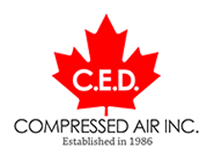Compressed Air Dryers: The Different Types and Their Operating Principles
The use of air compressor dryers is essential in many industrial facilities that require a constant supply of dry, compressed air. It is essential to understand the various types of compressed air dryers and their operating principles to select the right one for your facility.
What is a Compressed Air Dryer?
The purpose of an air dryer is to separate moisture from industrially processed air. Dryers are crucial to industrial operations because moisture in industrial air can damage pneumatic systems, freeze pipelines, cause corrosion to metal parts, and cause bacteria or mold growth inside pipes.
Things to Know Before Choosing an Air Dryer
It is important to keep in mind that your business may require multiple types of air compressors, as well as multiple types of air compressor dryers. When researching air dryers, it is wise to know a few things about your air compressor and your business:
- Your compressed air’s specific uses and temperature requirements.
- Your required pressure dew point – This figure is essential for the proper performance of your air compressor. It will also determine the type and strength of the dryer you need.
- The environment within which your air compressor operates.
The Three Different Types of Air Dryers
1) Refrigerated Air Dryers
These are widely used in industrial applications because of their relative ease of maintenance and relative cost-effectiveness. This type includes cycling, non-cycling, and variable speed dryers. For air-drying applications, refrigerated air dryers have no special requirements, such as minimum dew points, and work by cooling air to lower the temperature sufficiently to condense moisture.
2) Desiccant-type Air Dryer
Desiccant dryers use desiccant material – specialized drying agents – to adsorb water vapour from process air. A desiccant dryer system comprises two towers ‒ one that dries the air and another that regenerates the desiccant. Single towers are less common, and both are suitable in corrosive and hazardous environments without requiring electricity.
Desiccant materials are hygroscopic substances with a high affinity for water that act as dehumidifiers. The low dew point of these compressed air dryers makes them ideal for colder climates and industries that need super-dry air. There are three types of desiccant air dryers: heated, heatless, and heat of compression.
3) Membrane Dryers
These dryers are available with a choice of various types of permeable material to extract moisture from processed air. Often used for small projects and single points of use, these dryers are suitable for gas extraction applications, including food production. Membrane dryers are simpler to use, quieter and require less maintenance than other systems.
Today, compressed air dryers are an integral part of most compressed air systems. It is essential to select the right air dryer for your facility to extend its lifespan and avoid costly shutdowns.
Call us today at CED Compressed Air Inc for more information on our air-compressed dryers or to request a quote.

